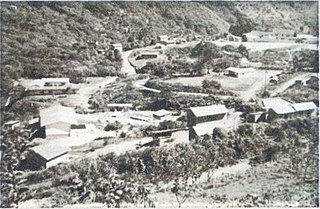Related Research Articles

Rurrenabaque is a small town in the north of Bolivia, on the Beni River. It is the capital of Rurrenabaque Municipality. In recent years, it has become popular with international tourism as it is an easy gateway for visits to Madidi National Park, which is within the Bolivian rainforest. It also provides access to the surrounding pampas. Locals commonly refer to the town by its shortened nickname, "Rurre."

The Yungas is a bioregion of a narrow band of forest along the eastern slope of the Andes Mountains from Peru and Bolivia, and extends into Northwest Argentina at the slope of the Andes pre-cordillera. It is a transitional zone between the Andean highlands and the eastern forests. Like the surrounding areas, the Yungas belong to the Neotropical realm; the climate is rainy, humid, and warm.

Caranavi is the capital of the Caranavi Province in the Yungas region of Bolivia.

Comunidad Inti Wara Yassi (CIWY) is a Bolivian non-governmental organization dedicated to environmental education and the care of sick, mistreated and abandoned wildlife. It is the country's largest destination for confiscated wildlife and currently cares for around 500 animals, most of them rescued from the illegal wildlife trade.

Coroico is a town in Nor Yungas Province, in the La Paz Department of western Bolivia.

World Animal Protection, formerly The World Society for the Protection of Animals (WSPA), is an international non-profit animal welfare organization that has been in operation since 1981. The charity's mission is to create a better world for animals by protecting them.

Madidi is a national park in the upper Amazon river basin in Bolivia. It was established in 1995 with a total land area of 18,958 km2. Together with the nearby protected areas Manuripi-Heath and Apolobamba and the Manu Biosphere Reserve (Peru), Madidi is part of one of the largest protected areas in the world.

Afro-Bolivians are Bolivian people of Sub-Saharan African heritage and therefore the descriptive "Afro-Bolivian" may refer to historical or cultural elements in Bolivia thought to emanate from their community. It can also refer to the combining of African and other cultural elements found in Bolivian society such as religion, music, language, the arts, and class culture. The Afro-Bolivians are recognized as one of the constituent ethnic groups of Bolivia by the country's government, and are ceremonially led by a king who traces his descent back to a line of monarchs that reigned in Africa during the medieval period. They numbered 23,000 according to the 2012 census.

Chulumani is a municipality in Bolivia. It is the capital of the Sud Yungas region. Agriculture dominates the area, which produces bananas, coffee, and coca leaves. Chulumani is subtropical with warm temperatures and high humidity.

Nick Brandt is an English photographer. Nick Brandt's photographs focus on the impact of environmental destruction and climate breakdown, for both some of the most vulnerable people across the planet and for the animal and natural world.

Carmen Pampa is a community in Bolivia situated 112 km from La Paz. Carmen Pampa is in the municipality of Coroico, the capital of the Nor Yungas Province of the La Paz Department, Bolivia. According to Holdridge life zones classification, it is ecologically a premontane tropical moist forest. The population is composed mainly of Aymara people, mostly farmers. The community also hosts the Unidad Académica Campesina-Carmen Pampa and the San Francisco Xavier High School.
Chuqi Tanka is a 4,686-metre-high (15,374 ft) mountain in the Andes of Bolivia. It is located in the La Paz Department, Murillo Province, La Paz Municipality, near the border with the Coroico Municipality of the Nor Yungas Province. Chuqi Tanka lies east of Ch'uñawi.
P'iqi Q'ara is a 2,672-metre-high (8,766 ft) mountain in the Andes of Bolivia. It is located in the La Paz Department, Nor Yungas Province, Coroico Municipality.
Kimsa Warmini is a 2,842-metre-high (9,324 ft) mountain in the Bolivian Andes in a small range of that name. It is located in the La Paz Department, Nor Yungas Province, Coroico Municipality, northeast of Coroico. The range extends in a north-easterly direction.

Adalberta Mónica Rey Gutiérrez is an Afro-Bolivian cultural leader and activist whose anthropological research helped pass legislation for formal recognition of Afro-Bolivians as an ethnic category in the census of the country. After serving as an educator and cultural activist for many years, she went to work in the government. She is currently a supranational delegate in the Plurinational Legislative Assembly of Bolivia.
Nina Py Brozovich is a Bolivian climate activist. She founded Fridays For Future in Bolivia. She was a part of the United Nations Youth Climate Summit.
The Zongo Valley is an Andean valley, located 76 km (47 mi) northwest of the city of La Paz, in the Pedro Domingo Murillo Province, La Paz Department, Bolivia. The valley follows the course of the Zongo River and is located within the Cordillera Real, from the Huayna Potosí mountain at 6,090 m (19,980 ft) above sea level and up to 800 m (2,600 ft) above sea level, in the tropical area of the Bolivian Yungas.
References
- ↑ Shepherd, Harry (1 July 2012). "Bolivian wildlife under threat". Bolivian Express. Retrieved 14 April 2014.
- ↑ "Volunteering at La Senda Verde Wild Animal Refuge". The Counterintuitive. Retrieved 23 March 2014.
- ↑ Oblitas, Monica; Sagárnaga, Rafael (30 May 2010). "La fiebre del oro amenaza a Coroico". Los Tiempos. Archived from the original on 3 March 2016. Retrieved 14 April 2014.